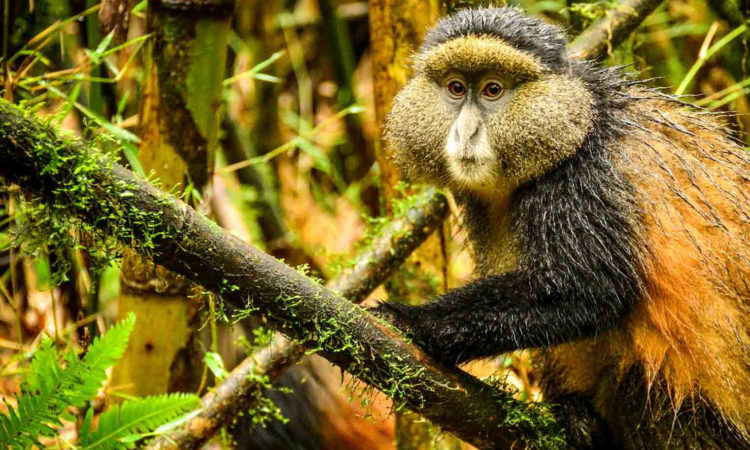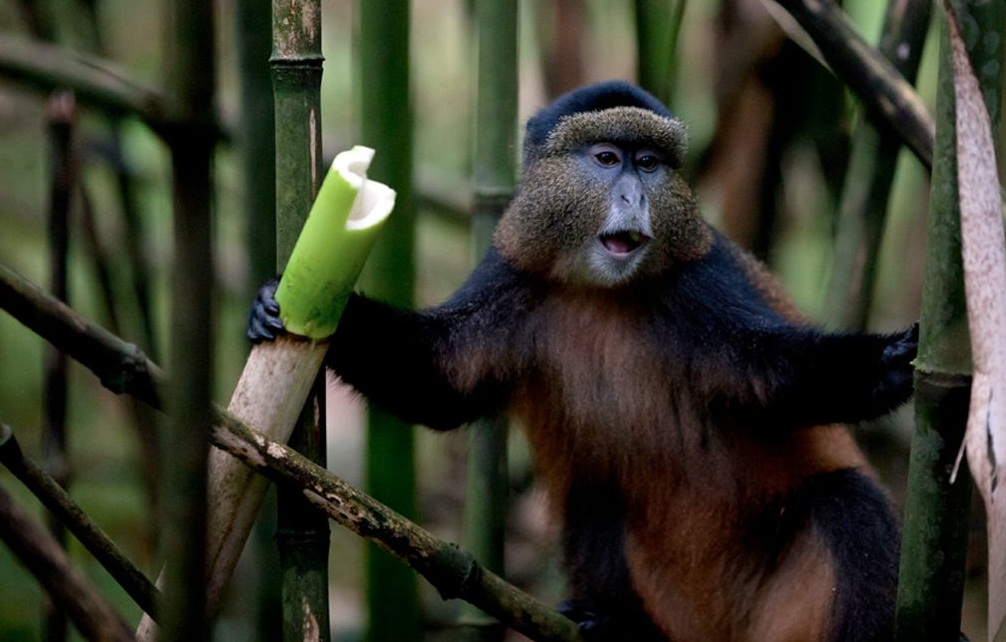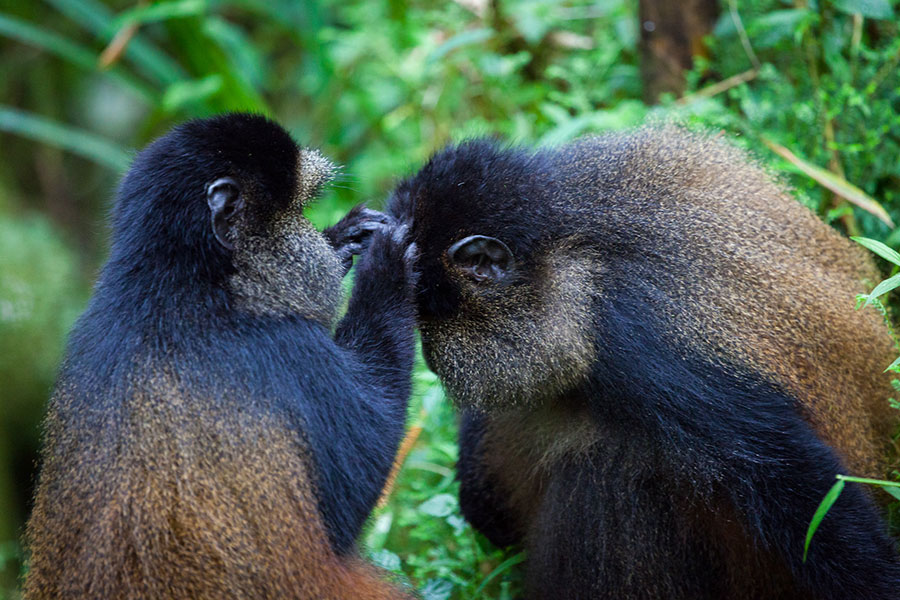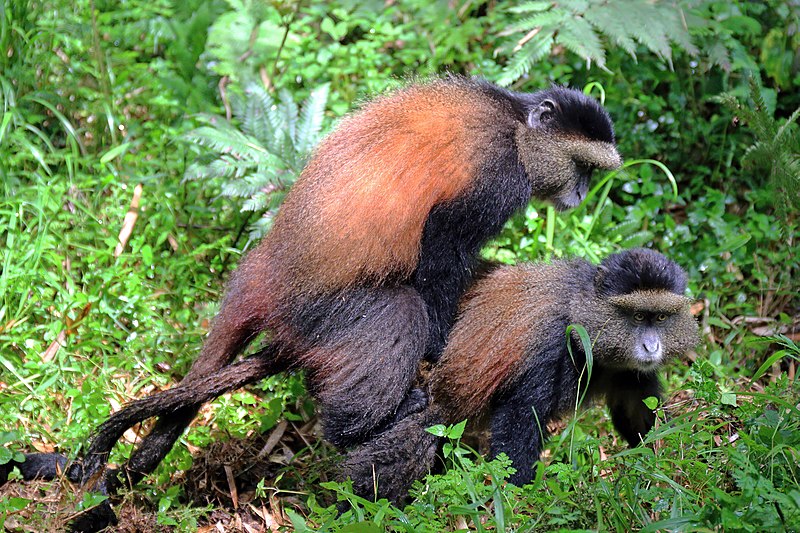6 Facts About Golden Monkeys
6 Facts About Golden Monkeys: A traveler or someone who is interested in primates should familiarize themselves with the following six facts about golden monkeys. The Virunga Mountains, which are shared by three distinct East African countries where you may go on an East African safari, are home to some of the world’s most endangered primate species, including golden monkeys.
There are many activities available in the Virunga Mountains, such as gorilla tours in Rwanda, gorilla trekking in Mgahinga National Park, Rwanda cultural tours that take you to the Ibyiwacu Cultural Village, birding in Rwanda on the various Virunga Mountains, hikes up Karisimbi Mountain and Nyiragongo Mountain, among others. However, one activity that is becoming more and more popular, similar to gorilla trekking, is golden monkey trekking, which is available in Mgahinga National Park, Volcanoes National Park, and Virunga National Park.
In order to make your visit to the primates unforgettable, it is advised that you are aware of the following information about golden monkeys before embarking on a golden monkey trekking adventure.
1. Habitat: One of the six most important facts about golden monkeys is this. Only in the Albertine Rift, particularly in the Virunga Mountains, are golden monkeys found. These primates can be seen in several national parks, including Kahuzi Biega National Park, home to eastern lowland gorillas, and Virunga National Park, which is well-known for its wide range of activities, including the hike up the Nyiragongo Mountain, where visitors can learn about various hiking-related facts.
Aside from visiting the Senkwenkwe gorilla orphanage and the many Congo gorilla families, you will also participate in the park’s Congo gorilla tours, which will add even more special touches to your unforgettable stay. Rwanda‘s national parks for volcanoes and mgahinga gorillas are the places to go on gorilla trekking and Rwandan gorilla tours, respectively.

Due to their preference for eating bamboo, which is their main food source, golden monkeys are highly gregarious animals that live in various groups depending on the elevation in which they are found. As a result, the size of the group varies according to the elevation at which the monkeys are found. The troop of golden monkeys that may be seen is less the higher in elevation they can locate food.
2. Diet: Of the six things to know about golden monkeys, this is an important one. Similar to gorillas, golden monkeys are herbivorous primates who mostly consume the shoots and branches of bamboo trees, though they can also eat flowers and, on rare occasions, invertebrates like termites and snails. However, it should be mentioned that golden monkeys often leave the bamboo in order to gorge themselves on fruit during seasons when it is easily accessible. The reason why golden monkeys are so fascinated in fruit is still unknown, however they will select fruit when it is easily accessible in places with bamboo and fruit.

3. Social structure: Golden monkeys often live in large groups, with an adult male serving as the group’s dominant individual and engaging in mating activities with the several adult females. There are more females in the golden monkey group than males. There will always be more females in a group than males, though occasionally there will be two or three males among the females. Additionally, the dominant male serves as the group’s general seer and is responsible for keeping everyone safe.
4. Behavior: If you’re interested in learning more about the golden monkey’s interesting behavior in the wild, you can take part in golden monkey trekking in Rwanda. The gorillas, who sleep in a new nest each night, are considerably different from the golden monkeys; further information about their behavior can be found in the 10 facts about gorillas. Though they may have traveled a great distance, the golden monkeys can return to the same nest where they spent the night following a full day of foraging. And they primarily like places with an abundance of fruit and bamboo.

5. Reproduction: For the sake of procreation, a dominant male in the golden monkey group is entitled to mate with any adult female in the group. An adult female gives birth to a baby with all of its fur during the six-month gestation period. The golden monkeys have a specific season for mating, which presents another challenge to growing their population because it restricts their ability to reproduce, unlike other primates like gorillas who can mate at any time.
6. Physical structure: It goes without saying that this is one of the six facts about golden monkeys. The golden monkeys’ outstanding beauty stems from their fur coated in gold, which attracts a lot of tourists who are interested in seeing them. However, for some tourists visiting East Africa, this is not the primary reason for their fascination.In addition to having difficult-to-distinguish golden and black fur, males and females can be distinguished from one another by subtle color variations. Males have a darker coat of black and gold fur, whereas females have slightly paler and lighter fur. Since little is known about monkeys, participants can learn more about these fascinating primates by going on golden monkey trekking excursions in Rwanda, the Democratic Republic of the Congo, and Uganda.
